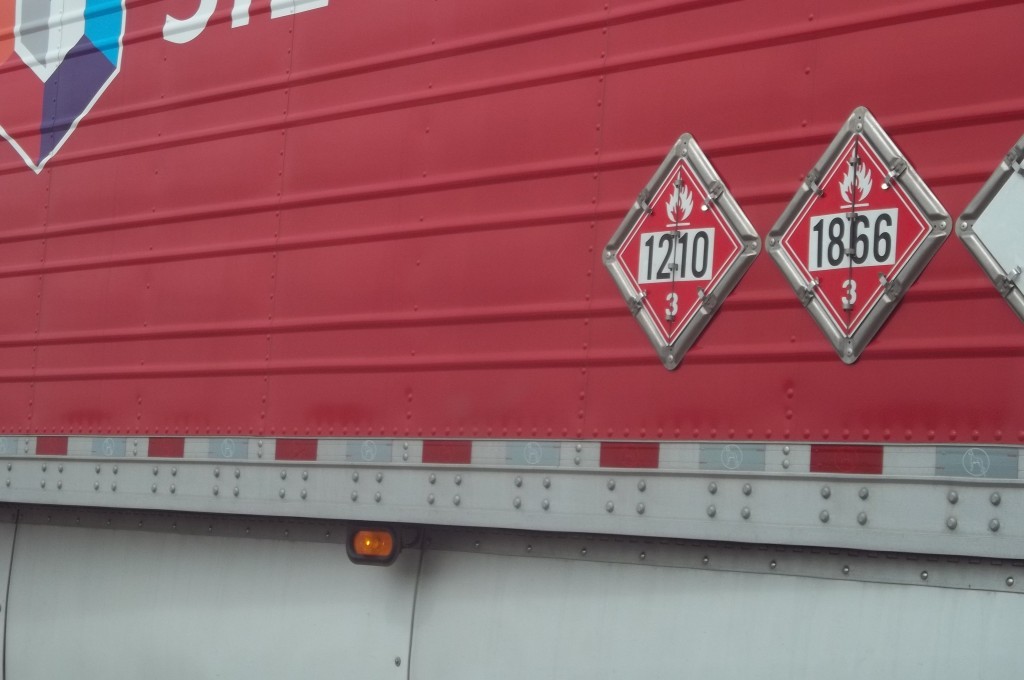An identification number, though usually displayed on or in association with a placard on a vehicle or bulk container, must be in compliance with the Marking requirements of 49 CFR 172, Subpart D and not the Placarding requirements of Subpart F. And it is in 49 CFR 172.334(d) that a little known prohibition on the use of the identification number on placarded vehicles can be found. Simply stated, the regulation prohibits the use of an identification number on a placard unless the identification number is applicable to all of the hazardous materials of the same hazard class in the vehicle.
Consider: A truck is to be loaded with the following hazardous materials…
- UN 3264, Waste Corrosive Liquid, Acidic, Inorganic, n.o.s (Hydrochloric Acid, Hydrogen Peroxide), 8, II – 6 x 55 gallon drums @ 600 lb/drum = 3,600 lbs
- UN1760, Waste Corrosive Liquid, n.o.s. (Nitric Acid, Hydrofluoric Acid), 8, II – 1 x 350 gallon bulk packaging = 350 lbs
Per the US Department of Transportation (US DOT) regulations at 49 CFR 172.504(c), a CORROSIVE placard is required on all four sides of the vehicle for two reasons:
- The gross weight of the hazardous material shipment is >1,001 lbs; and,
- A bulk packaging of a hazardous material is part of the shipment.
Further, 49 CFR 172.331(c)mandates the use of the identification number on all four sides of the vehicle since the identification number on the bulk packaging (UN1760) is not visible inside the closed transport vehicle.
The usual response to this situation is to placard the vehicle CORROSIVE on all four sides with the identification number (UN1760) for the bulk packaging on the placard. All is well, right? Not so fast there Shipper! 49 CFR 172.334(d) seems to prohibit the display of the identification number on the placard in this case. Why? Because the identification number may only be displayed if it represents all the hazardous materials in that hazard class loaded on the vehicle. Since the six drums of Waste Corrosive Liquid, Acidic, Inorganic, n.o.s. has an identification number of UN3264, the identification number of UN1760 cannot be displayed solely on the CORROSIVE placard. But, 49 CFR 172.331(c) requires the display of the identification number on all four sides of the vehicle. Pretty confusing huh?
The solution is to display each applicable identification number in one of the following manners:
- On an orange panel near the placard. You can use as many orange panels as necessary.
- On a white square-on-point near the placard. You can use as many white square-on-points as necessary.
- On separate placards of the same hazard class. As demonstrated by the photo below:

Class 3 placard with identification number for Printing Ink or Printing Ink Related Material (UN1210) and Resin Solution (UN1866)
And what does it matter to you anyway? You’re a shipper of hazardous materials, not a carrier. Placarding is the responsibility of the carrier, right? Wrong. 49 CFR 172.506(a) reads: “Each person offering a motor carrier a hazardous material for transportation by highway shall provide to the motor carrier the required placards for the material being offered prior to or at the same time the material is offered for transportation, unless the carrier’s motor vehicle is already placarded for the material as required by this subpart.” And 49 CFR 172.300(a) reads: “Each person who offers a hazardous material for transportation shall mark each package, freight container, and transport vehicle containing the hazardous material in the manner required by this subpart.” Since you are offering the hazardous material (which includes hazardous waste shipped on a Uniform Hazardous Waste Manifest) to a motor carrier for transportation it is your responsibility to ensure the bulk packaging and vehicle are properly placarded and marked.
|
Contact me with any questions you may have about the transportation of hazardous materials by air, highway, vessel, or rail International and Domestic Daniels Training Services 815.821.1550 |
There are many aspects of DOT’s Hazardous Material Regulations (The HMR) that place the burden of responsibility on the person who offers hazardous materials for transportation in commerce (i.e. the Shipper). As a shipper of hazardous materials – including hazardous waste – it is important for you to be familiar with all of your regulatory requirements.